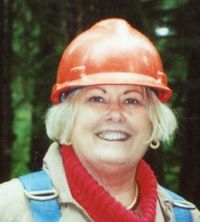
Ruth Annette Gabriel Reck
Professor of Atmospheric Science, Emerita
Professor Emerita Ruth Annette Gabriel Reck, a pioneer in climate change studies, died April 18, 2024, in Bloomington, IN at age 88. She joined the Department of Land, Air and Water Resources faculty in 1999, while serving as the Director of the US Department of Energy’s National Institute of Global Environmental Change at UC Davis from 1999 to 2004. She retired from the UC Davis faculty in 2012.
She graduated from what is now the University of Minnesota Mankota at age 18, at the time the youngest ever to be awarded a Bachelor’s degree there, double majoring in Chemistry and Mathematics. She proceeded to earn her doctorate in Physical Chemistry at the University of Minnesota, then was a postdoc in Applied Mathematics at Brown University. She started her career at General Motors researching binary alloy magnetic materials, Einstein-deHass experiments, and quantum mechanics perspectives for ferromagnetic nickel. She began shifting her focus to global climate change research, specifically the study of the complex effects of trace gases, aerosols, and clouds and the quantification of global warming caused by anthropogenic emissions. Her early global climate change studies were in high profile venues such as Science and Nature. These pioneering studies used advanced models developed at Princeton to simulate the effects of different aerosol types and different surface albedos on climate change. She was the first climate scientist to introduce aerosol Mie Scattering effects into global radiative-convective climate models and she demonstrated how aerosol impacts on surface temperature depended on albedo, cloud height, aerosol size, and particle optical properties. She expanded her studies to include climate effects from carbon dioxide, chlorofluorocarbons, moisture and cloud formation heights, surface albedo, and other trace gases. She showed climate change effects were strongly latitude dependent and included the possibility of enhanced warming in polar regions with increased ice cap melting. She also showed that aerosol emissions would not compensate for greenhouse gas warming. Many of these pioneering advances are striking and were ahead of her time. Her groundbreaking research was especially remarkable, given that at the time, according to a Scientific American website article, she faced sexism as the first female scientist at the GM lab. The article reported that her workspace glass walls were literally “walled off” with conventional opaque walls, to prevent men from staring at her.
According to a report by E&E News released in 2020, she presented her work to several high-level executives at General Motors more than 50 years ago, showing that global warming was occurring from anthropogenic greenhouse gas emissions. Although this large automotive corporation was aware of the dangers of greenhouse gas emissions from her studies, it continued to ignore this knowledge in their corporate strategies for years, according to the report.
She transitioned to Argonne National Laboratories in 1992, where she coordinated research on a variety of topics such as the effects of transportation, including aviation, on climate, radiative effects on climate, biosphere-atmosphere interactions, climate change effects on ecosystems and humans, and policy and economic aspects of climate change.
As the DOE NIGEC Director sited in UC Davis, she oversaw six regional centers at Harvard, Tulane University, the University of Alabama, the University of Nebraska, Indiana University, and UC Davis. During this time, she had to fight for increased funding and support from DOE for NIGEC. NIGEC and its regional centers were instrumental in supporting and expanding the early AmeriFlux network to monitor carbon and water exchange, leveraging the regional programs to support monitoring of carbon sequestration from ecosystems across the continent. During her tenure as NIGEC director, AmeriFlux expanded from 25 to 87 stations; currently it has 665 registered stations. Because of the decision to focus on carbon and water exchange, one important micrometeorological study funded by NIGEC through its regional centers established that 400-500 year old ancient coniferous forests, conventionally though to be carbon neutral, were still absorbing carbon from the atmosphere.
Dr. Reck had many kudos to her name, including awards from the Engineering Society of Detroit, the University of Minnesota, Michigan Technological University, the University of Georgia, and her alma mater Minnesota State University. She served on National Research Council committees, and US commissions, and was on the Board of Regents for Michigan State University. Besides these academic honors, she had diverse work experiences, including driving large trucks and operating construction cranes.
She also led climate change initiatives at Oxford University Round Tables on global warming and sustainable development, together with an MIT colleague, in 2007 and 2008. These activities led to her arranging and editing the book, “Climate Change and Sustainable Development” in 2010, along with writing a chapter in the book.
While a Professor at UC Davis, she taught three courses: Global Climate Change, Severe and Unusual Weather, and Atmospheric Radiation and Satellite Meteorology. She was a member of the Atmospheric Science Graduate Group, two computer/IT committees, and several Academic Senate committees. As a professor, she continued her research on global climate change and the impacts of climate change on economically emerging countries. She had over 200 refereed publications.
Dr. Reck is survived by her daughter Cate Reck, son Ronald Reck, and grandson Sabien Reck. The family suggests donations to the Environmental Justice Fellows Program at the O’Neill School of Public and Environmental Affairs at Indiana University.
Kyaw Tha Paw U
Susan Ustin
